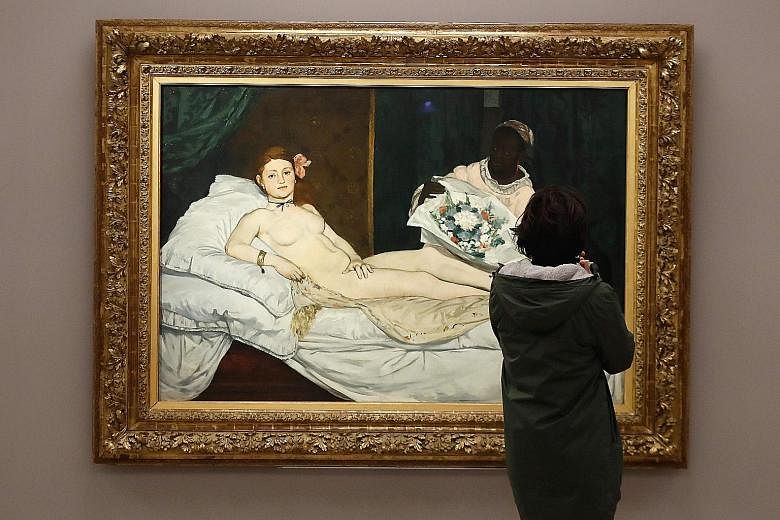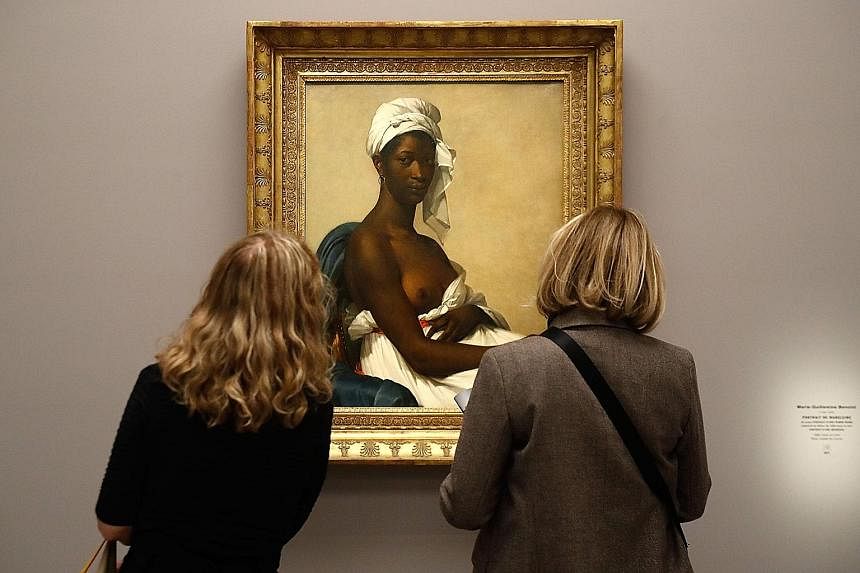PARIS • French art masterpieces have been renamed after their long overlooked black subjects in a ground-breaking new Paris show on the representation of people of colour in art.
French painter Edouard Manet's Olympia, the scandalous painting of a naked reclining prostitute that marks the birth of "modern art", has been rebaptised Laure after the woman who posed as her maid.
Several other major works have been similarly renamed, after curators of Black Models: From Gericault To Matisse - which opened yesterday at the d'Orsay Museum - turned historical detectives to hunt down the identities of their sitters.
The enormous exhibition, with paintings by Eugene Delacroix, Paul Gauguin, Pablo Picasso, Pierre Bonnard and Paul Cezanne, tackles the depiction of black and mixedrace people in French art from the country's final abolition of slavery in 1848 until the 1950s.
American scholar Denise Murrell said it reveals how black people played a major role in the birth of modern art in Paris, but were written out of the story.
From Jeanne Duval, the Black Venus who was mistress and muse to the poet Charles Baudelaire - and was also painted by Manet - to Alexandre Dumas, author of The Count Of Monte Cristo, Dr Murrell said "there was a black presence in avant-garde circles when artists and writers defied convention" when inter-racial socialising was taboo.
But the influence of people of colour has been eclipsed from art history by racism and stereotyping, she said.
Instead, their identities have been hidden behind unnecessary racial references such as negresse or mixed-race "mulatresse" - which comes from the French word for mule.
Dr Murrell and her fellow curators have revealed the subjects' names in new titles for the show, "which would have been the case if they had been European", she added, with the historic titles relegated to the second line.
The tone is set from the stunning opening Portrait Of A Negress - renamed Portrait Of Madeleine for the show - painted by Marie-Guillemine Benoist in the short period between the French Revolution's abolition of slavery in 1788 and Napoleon reinstating it in 1802.
"For more than 200 years, there has never been an investigation to discover who she was - something that was recorded at the time," said Dr Murrell.
"This is emblematic. It was art history that left them out. It has contributed to the construction of these figures as racial types as opposed to the individuals they were," she added.
Yet, black people featured in some of the greatest artworks of the period, with Theodore Gericault giving three starring roles as desperate shipwrecked sailors in his masterpiece, The Raft Of The Medusa.
The painter's favourite model, an art-loving Haitian called Joseph, the heroic figure on the raft, finally gets his place in the limelight in the show.
It also hails campaigning work that abolitionist artists such as Gericault did to end slavery.
But abolition, as Cezanne's The Negro Scipio demonstrated, did not mean the end of discrimination and despair.
Until a wave of volunteers from France's African colonies fought in the trenches of World War I, black Parisians were often confined to working as servants, circus performers, prostitutes, nannies and wet nurses, with black women's milk thought to be richer and more nutritious.
Old art world habits also died hard.
Even as American dancer Josephine Baker became a massive star in 1920s France, black models were still largely nameless and labelled as racial types, including those who sat for jazz fan Henri Matisse, who had travelled to New York to soak up the Harlem Renaissance of black culture.
His three black and mixed-race models, who included a well-known actress and journalist, finally get their due in the show.
But it is Manet's maid who is its real star.
She appears in no less than eight takes on his canvas, including two modern versions: Olympia In Black Face by American artist Larry Rivers and Congolese artist Aime Mpane's even wryer Olympia II, which turns the tables with a white servant offering a bouquet containing a skull to her black boss.
Black Models: From Gericault To Matisse, a massively expanded version of a show last year at New York's Wallach Art Gallery, based on Dr Murrell's doctoral thesis, runs till July 21.
AGENCE FRANCE-PRESSE


